
MITSUBISHI Colt 3 Doors
Generations Timeline, Specs and Pictures
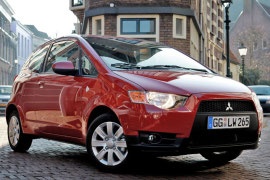
Mitsubishi tried a new approach on the small-segment market with a 3-door version for the Colt in 2004.
Four years later, it brought a facelifted version.
In Europe, the small-segment was very important for most of the carmakers. Apart from the premium carmakers, all of the other players had a vehicle involved. Mitsubishi was the only one to offer a 3-door, egg-shaped, small MPV.
The 2008 3-door Colt featured a new front fascia, with a “Jet Fighter” grille design inspired by the Lancer. That wide opening continued from the hood to the lower apron in an A-shaped form. On the sides, the B-pillars received a black foil to create a floating roof design look. For the five-door, the D-pillar received the same treatment. The redesigned taillights visually connected the rear quarter-panels with the tailgate. While on the base trim level, the car featured steel-wheels with plastic caps, Mitsubishi offered the Colt with light-alloy wheels from the middle trim-level up.
Inside, the car featured more hard-plastic areas on the door panels, the dashboard, and the ridiculously small center console. At least, it offered two cup-holders for the front occupants. There was a pattern on that plastic that made it look better. The three-door version featured a shorter wheelbase, which leads to small legroom for the rear passengers.
Mitsubishi offered the Colt with a choice of three gasoline engines, ranged from a 1.1-liter to a turbocharged 1.5-liter, which offered between 75 hp and 150 hp, respectively. All versions were paired to a 5-speed manual, and there was no automatic transmission on the options list.

The Ralliart was for Mitsubishi Colt, what the GTI was for the Volkswagen Polo: a special version meant for those who want more from a little car.
While the world economy started to collapse, affected by the financial crisis, Mitsubishi refreshed the 2003 Colt small-segment MPV. The vehicle was available in a three and five-door version. The new Ralliart package was more than just a sticker on the tailgate and some decals on the sides.
Mitsubishi offered the 150 hp Colt only on the 3-door version for the non-facelifted model. That was corrected after 2008 when that engine was available for the 5-door as well. Both vehicles featured a new front fascia, with a “Jet Fighter” grille design. That wide opening continued from the hood to the lower apron in an A-shaped form. The inspiration came from the flagship model Lancer Evolution X. On the sides, the B- and C-pillars received a black foil to create the floating roof design look. For the five-door, the D-pillar received the same treatment. At the back, on top of the tailgate, a roof-spoiler enhanced the car’s sporty look.
Inside, the car featured more hard-plastic areas on the door panels, the dashboard, and the ridiculously small center console. At least, it offered two cup-holders for the front occupants. There was a pattern on that plastic that made it look better. The instrument cluster didn’t look to have a high-quality. Still, it provided all the necessary information about the revs, the speed, coolant temperature, and the fuel level. On the three-door version, the shorter wheelbase reduced the legroom for the rear bench occupants.
Mitsubishi installed a 1.5-liter turbocharged engine under the hood, which provided 150 hp. It was mated to a standard 5-speed manual gearbox.
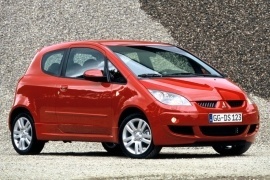
Mitsubishi introduced a new version for its European-designed supermini and installed a turbocharged engine under Colt’s hood.
In Europe, the supermini segment was crowded by most of the Italian, French, and German carmakers. Also, other Japanese brands offered their products on the same market. Mitsubishi considered that it might get an edge with a more powerful version and introduced a sportier version for the Colt.
In the CZT version, the three-door Colt showed a more aggressive styling. At the front, the bumper featured a triple air intake in the apron, compared to a broad, slatted one from the regular CZ3. Its grille sported a rhomboidal mesh design, inspired by its bigger brother Lancer Evolution. From its sides, the body-colored door mirrors and the unique light-alloy wheels were specific for the CZT, while at the back, a roof spoiler adorned the top of the tailgate.
Inside, Mitsubishi introduced white dials with red needles for the instrument panel, with a wide speedometer in the middle marked up to 240 kph (149.1 mph) instead of 220 kph (136.7 mph) from the regular CZ3. A set of sport bucket seats replaced the regular ones from the rest of its stablemates.
Under the skin, the carmaker asked its motorsport department to enhance the supermini hatchback. Apart from the 150 hp turbocharged 1.5-liter engine, the engineers tuned the suspension and installed disc brakes in the back instead of drums.

Fuel saver or pocket-rocket, the Colt CZ3 had them all.
But the uninspired design, pricing policy, and interior material quality were a drawback for the supermini vehicle.
It might be named the fifth generation of the Colt and it was designed in Europe, for the European roads and crowded cities. With a sharp nose and a flat back, the Colt was developed on the same platform with the Smart FourFour. The three-door version was shorter than its five-door sibling but featured the same wheelbase.
From the outside, the sloped front featured a hood almost in the same line with the windshield. A short roof and an almost vertical back shaped the car in a sporty-style. The long doors and small rear windows made the car look shorter than it actually was. Due to its mini-MPV style, it featured a second pillar after the windshield, where the doors were hinged. The D-pillar was thick and for that reason, it had a big blind-spot.
Inside, the Colt CZ3 featured a pair of comfortable seats in the front with pockets and cup-holders mounted between the seats and the door panels. The rear seats were difficult to access, despite the longer doors, but once seated the two occupants had a decent amount of legroom and headroom. The trunk was small since the car was shortened from the back, not from the front.
Since it was made as an economy car, it was fitted with small gasoline and diesel engines, ranged between 75 hp and 109 hp. A special version, named CZT, featured a 1.5-liter turbocharged unit with up to 150 hp. That one was the pocket-rocket.
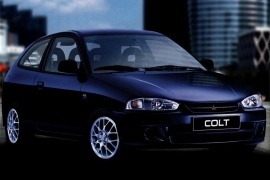
Having reached its 5th generation, the Colt saw quite a number of improvements over the previous series, mostly visually.
Freshly designed, the new Colt was powered by a choice of two petrol engines with capacities of 1.3 L and 1.6 L. Despite good handling and overall good engine reliability, the Colt is not one of the safest car. Base level trims came with only a standard driver’s front airbag while anti-lock brakes were missing. However, the now aged Colt is a bargain nowadays and given the car’s low maintenance and servicing costs as well as its good fuel efficiency, its not exactly a junk-yard car.
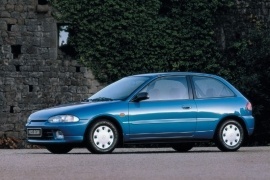
Mitsubishi introduced the fourth generation of the Mirage-based Colt in 1992, and while its sibling was doing well, the Colt had some troubles.
While the subcompact hatchbacks were doing well on the market, Colt struggled to survive. It had all the attributes to succeed, but it lacked the look that could make it sell like hotcakes. Its bland styling and not very inspired marketing decisions led to slow sales, at least for the three-door hatchback version as it was sold in Europe. In other parts of the world, its siblings Mirage and Lancer were just fine.
The bio-design era was not yet started, but Mitsubishi noticed the new trend and asked its designers to make a vehicle with more rounded lines and soft shapes. They managed to do that, but it was too early. Its semi-elliptic headlights and short hood were not, yet, very appreciated in Europe at those times. That’s why Opel/Vauxhall Astra (F-generation) outsold it, and the same went for other brands. It only came in a three-door version, and that was a huge mistake on a market where the hatchbacks were the choice of young families. In the back, the trunk was adequate for the car’s size, and the 50/50 split-folding rear seats could increase the luggage area.
Under the hood, Mitsubishi offered a decent engine choice for the Colt. There were three gasoline units to chose from. They were either fuel-efficient (such as the 1.3-liter) or punchy (the 1.8-liter GTI).
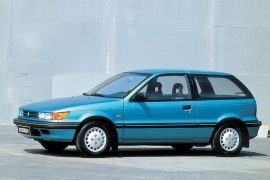
Mitsubishi introduced the third generation of the Mirage-based Colt in 1988, and in the three-door version, it was just a small-segment vehicle, while its four-door brother was the famous Lancer.
When the Japanese carmaker tried to expand its model range, it focused on affordable cars. Its target was to have as many cars on the roads as possible. That’s why it focused on the small-segment vehicles, and the Colt was one of its most important pieces of the puzzle.
Apart from the sportier versions, the rest of the range was rather dull than daring. Its front fascia was the part that showed more personality, thanks to its narrow headlights and swept-back turn signals. It wasn’t that much different from other cars from that era with a flat, vertical, narrow, and black grille. At least, its wrapped-around plastic bumper featured a black rubber strip on its upper section while the rest of it was body-colored. Mitsubishi’s designers extended an apron on the lower side and even offered it with big air intakes in the middle and sides. The car’s profile was typical for a Japanese hatchback, with wide doors and a big glass area between the B- and raked-forward C-pillar.
Inside, there was also little room for creativity from the carmaker’s design team. The flat dashboard featured a raised area in front of the driver, with the instrument panel inside. A pair of bucket seats with little bolstering supported the front passengers, while in the back, a split-folding seatback could accommodate two passengers.
Under the hood, Mitsubishi installed a choice of four gasoline engines with different power outputs, depending on the market. Apart from the base version, which sported a four-speed gearbox, the rest of the range featured a five-speed manual or a four-speed automatic.























































